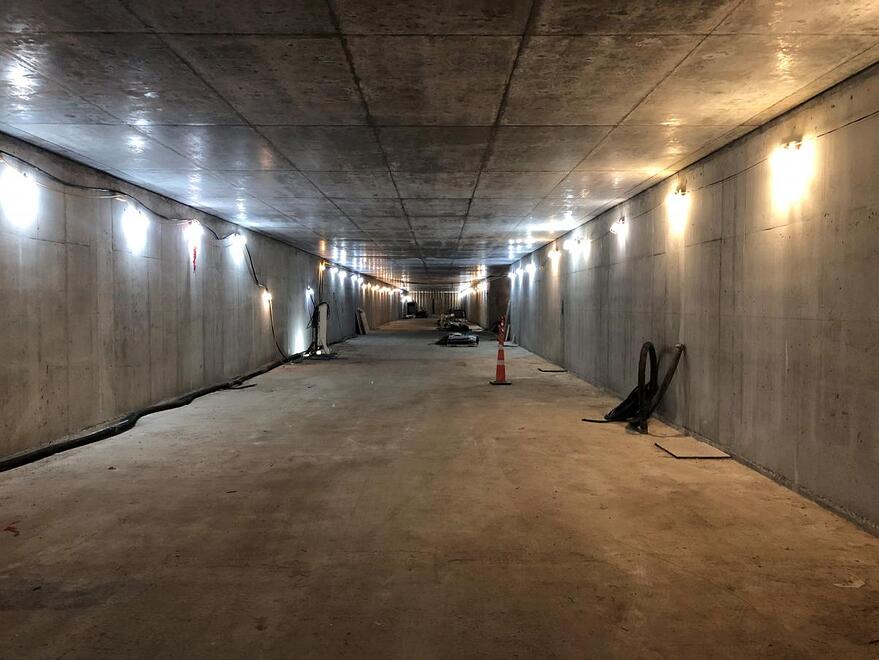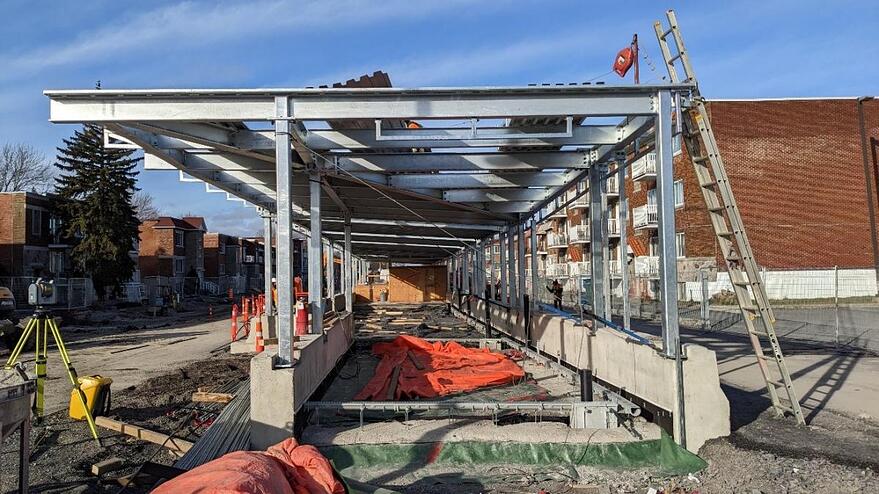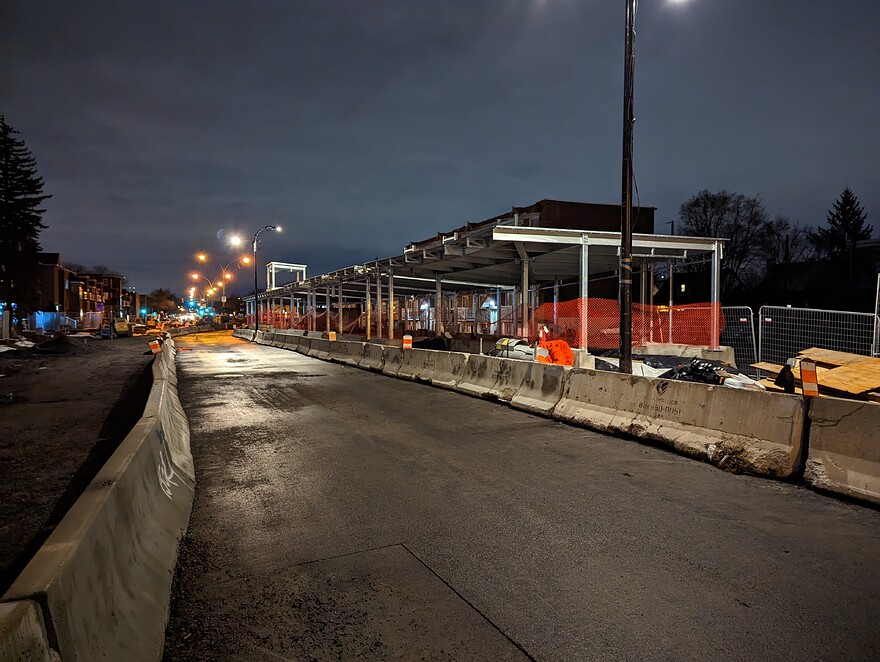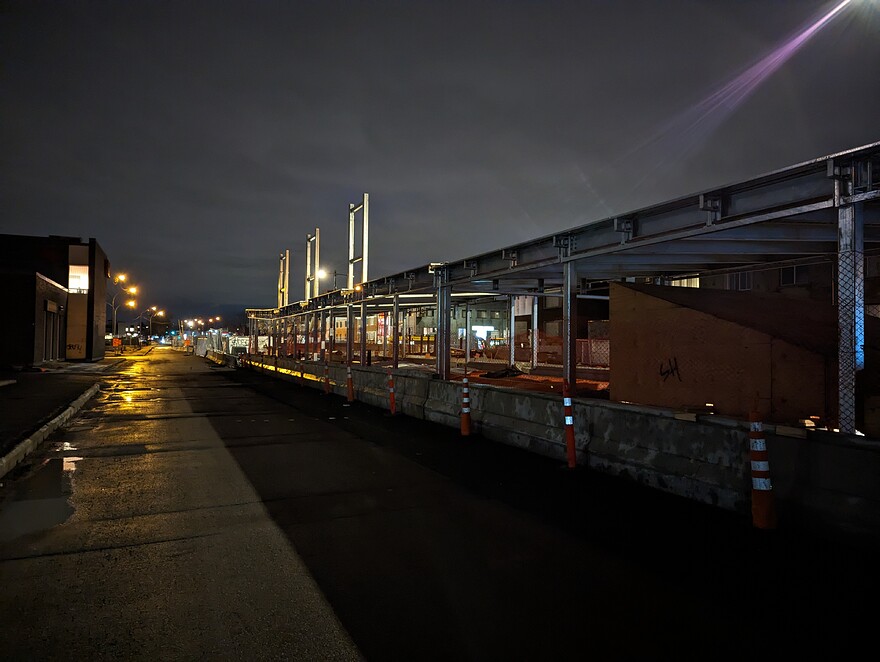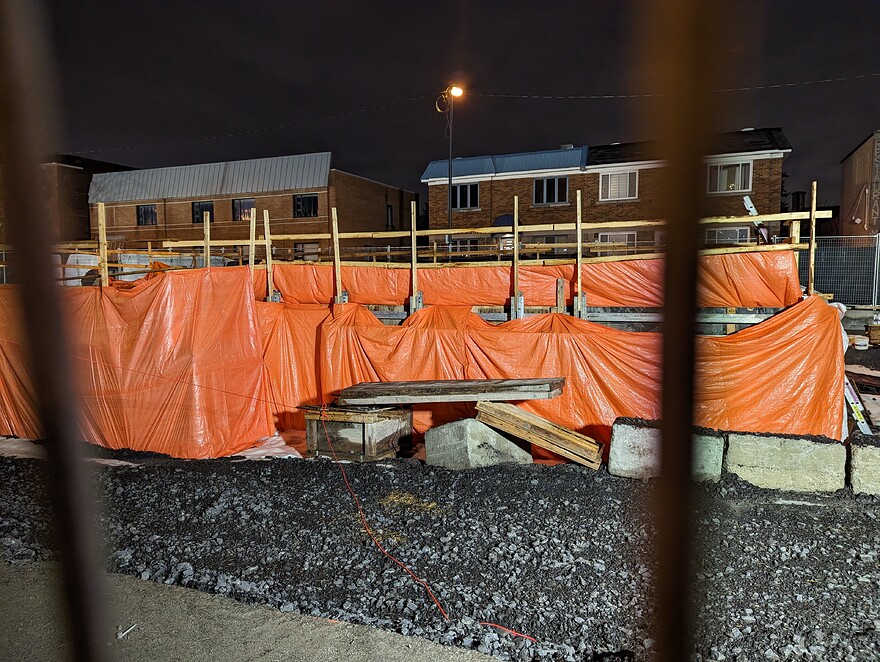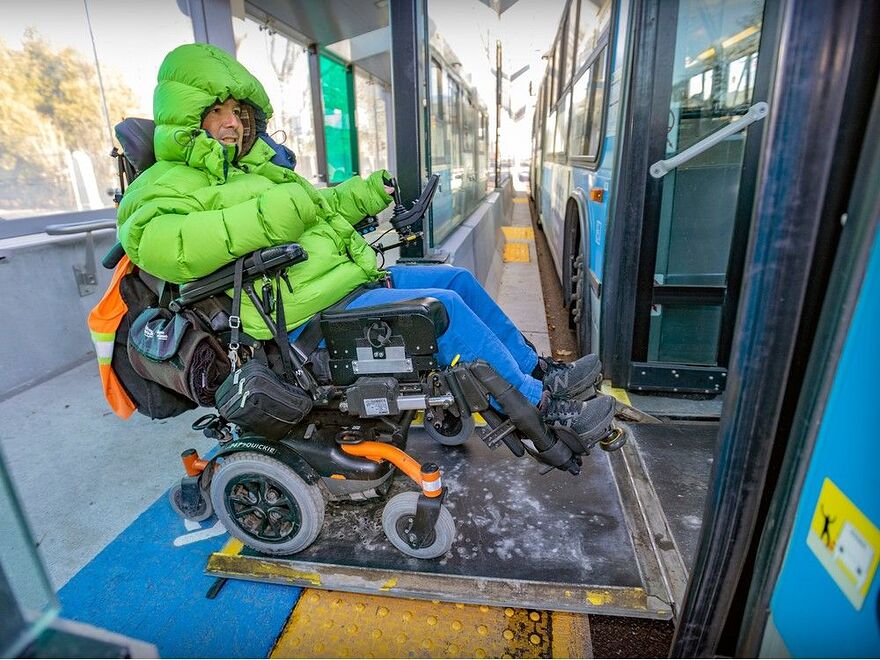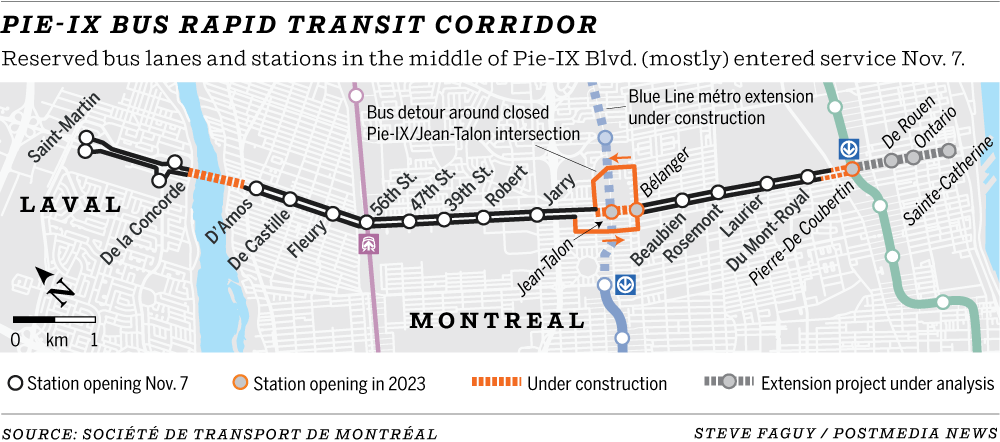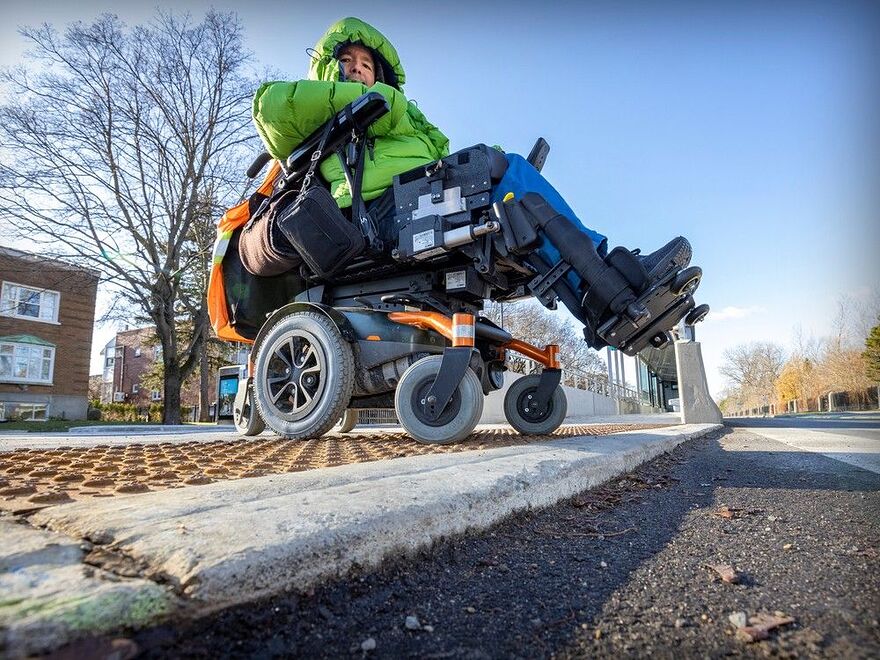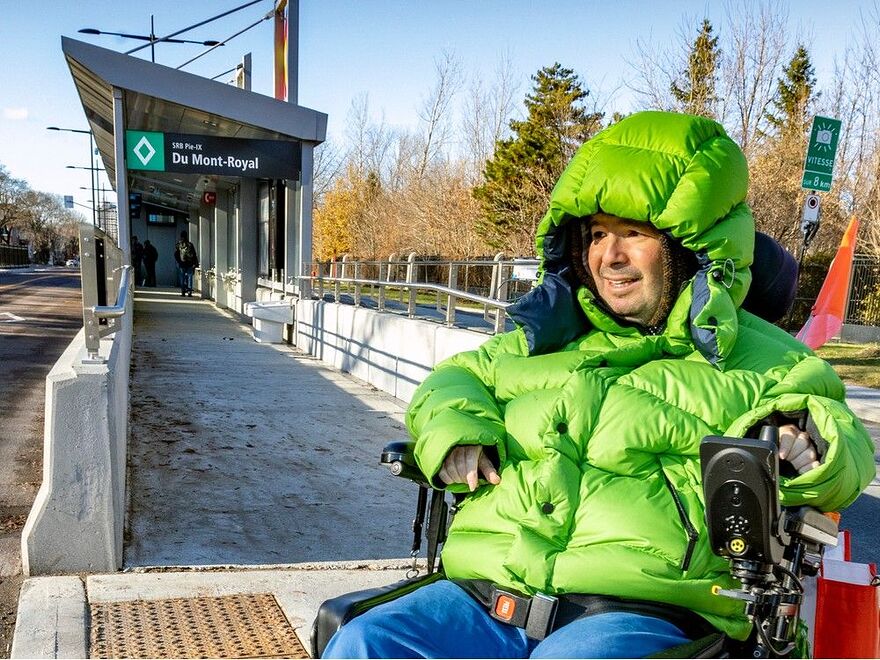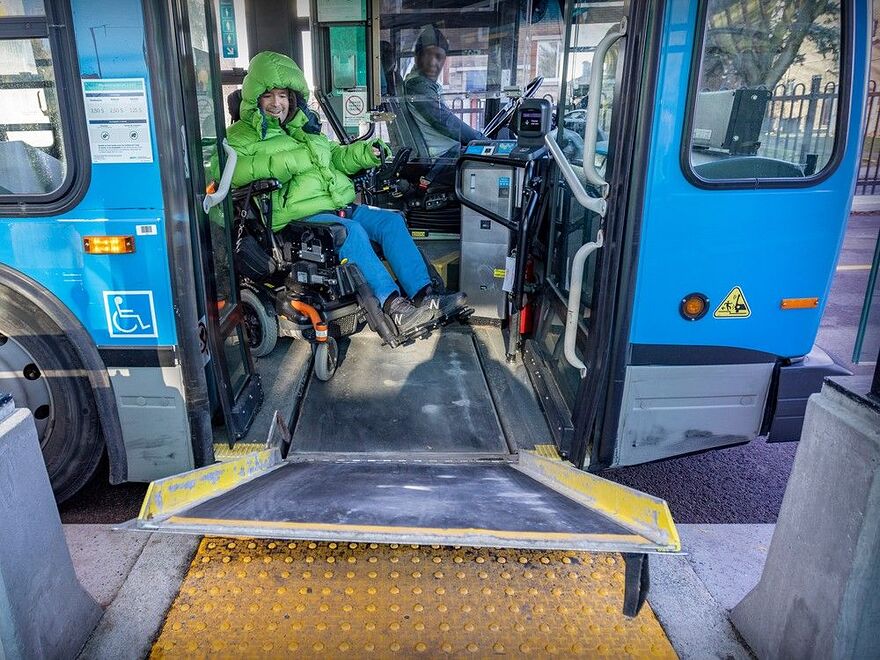La STM n’a pas adopté l’ADS+ dans ses projets comme la Ville de Montréal?
Accessibility issues found in Pie-IX bus rapid transit corridor
The Montreal Gazette toured the SRB Pie-IX and found several obstacles to those with mobility concerns.
Jason Magder
Gazette
Published Jan 12, 2023 • Last updated 3 hours ago • 6 minute read
Michel Dion gets on a bus at the Du Mont-Royal SRB Pie-IX station in Montreal Thursday Dec. 8, 2022. PHOTO BY JOHN MAHONEY /Montreal Gazette
The city’s newest transit infrastructure doesn’t live up to promises of universal accessibility, says a group that fights for the rights of those with mobility challenges.
The SRB Pie-IX is a $500-million rapid transit corridor along Pie-IX Blvd. without the interference of cars, and with priority for traffic lights. With 13 stations located in long bus shelters in the middle of the road, and more to come online in Laval, the corridor — known in English as bus-rapid-transit — promises to speed up travel time by about 30 per cent.
It went into service in November after nearly a decade of planning and construction, inaugurated with great fanfare by elected officials who vaunted its universal accessibility, among other benefits.
Having a bus transit system that is fully accessible is a boon for those who use wheelchairs, as it provides much-needed independence. Relying on adapted transit requires a reservation roughly 24 hours in advance, and rides are often cancelled in bad weather. The Regroupement des activistes pour l’inclusion au Québec has long complained about the lack of accessibility in the city’s transit network. It has filed a class-action lawsuit against the city, province and transit authorities seeking damages for the lack of access within the transit network — a case that will probably be heard in court next year.
The Montreal Gazette recently met RAPLIQ spokesperson Martin Dion to ride the 13 stations of the new system and he noted several deficiencies.
Ramps that don’t meet the sidewalk
It didn’t take long for Dion to find the first and perhaps most glaring failure of the STM’s newest infrastructure: sidewalk ramps don’t meet the street, leaving a gap of roughly one inch or more at certain stations.
With all the stations located in the middle of the road, with two lanes of traffic on either side of them, everyone getting on or off the bus must cross a street. Mont-Royal Ave. was the first station on the trip, and Dion noted a gap of roughly one and a half inches, or four centimetres, between the sidewalk and the road on the ramp to access the northbound station on the east side of the median.
Michel Dion stops next to an unacceptably high curb in the wheelchair ramp at the Du Mont-Royal SRB Pie-IX station in Montreal Thursday Dec. 8, 2022. PHOTO BY JOHN MAHONEY /Montreal Gazette
“This is a big problem,” Dion said. “It’s a step. It’s an obstacle. I can do it in my wheelchair, but for people in heavier chairs, or those with manual wheelchairs, it’s impossible, and it can even break a wheelchair. In my opinion, this is impossible for many people. It’s humiliating for people who are travelling here.”
It’s a similar situation at the next station: Laurier Ave., where the sidewalk on the northwest corner also isn’t flush with the street. One stop later, the situation is even more pronounced at Rosemont Blvd., where there are nearly two inches, or five centimetres between the sidewalk and road on the southeast corner to get to the southbound station. The Beaubien St. station makes it four in a row, as the northeast corner to cross to the southbound station is about an inch off the ground, or nearly three centimetres.
The final station where sidewalk ramps don’t meet is perhaps the one where it is most surprising to find deficiencies. The Amos station at the north end of the line was the first one to be built and it served for six years as a testing ground, notably for groups that represented people with mobility issues. Dion noted two sidewalk ramps at that station that didn’t meet the street, both of them between the northbound station and the sidewalk on the east side of the street.
Overall, Dion gives the STM and the city a failing grade on the new infrastructure, as the gaps make it difficult or impossible for people in wheelchairs to access five of the first 13 stations.
Reacting to Dion’s observations, STM spokesperson Justine Lord-Dufour said tests were done before the infrastructure was opened to the public and everything respected the norms in place. Furthermore, she said the Amos station — one of the ones where a failing was observed — served as a testing ground since 2016.
She said groups representing all forms of challenges were invited to give their feedback, and their comments were incorporated to the overall design of the project.
However, when shown photographs of the non-compliant ramps, Lord-Dufour said STM teams have already begun work to inspect the areas in question and will make corrections if needed.
Emergency phones that are too high to reach
In every shelter, there are red emergency phones so people can call for help if they are in trouble or need medical assistance. However, Dion noted that the phones are too high for many people in wheelchairs to reach. In his wheelchair, that is taller than most, he already had trouble reaching the phones.
“It should be low enough so that I can reach it without having to raise my arm too much,” Dion said. “This is definitely too high.”
Lord-Dufour said inspections have shown that the phones are placed within 1.2 metres of the ground, which is the permitted norm. She said this is the first place in the network an emergency button and a phone are available in the same place. Usually, it’s either a button or a phone in a métro or bus.
Storage boxes in the way
At every station, Dion also noted that there are plastic bins marked “The SOS Storage Bin,” that could become stumbling blocks for those who are visually impaired. Dion said the bins are in the passageway where people are going to be walking to the bus, and some people may not see them, as they are around knee height.
“These are in the wrong place,” he said. “They should be in the front, so they are out of the way of people getting to the bus.”
Lord-Dufour said the STM will take note of the observation.
“But keep in mind that we are well aware of the needs of our clientèle with visual difficulties,” she wrote in an email.
Lack of sitting areas
Michel Dion looks to cross Pie-IX Blvd after getting off a bus at the Du Mont-Royal SRB Pie-IX station in Montreal Thursday Dec. 8, 2022. Inside the station, a storage box sits at knee height, an emergency phone is installed too high, and there is nowhere to sit, Dion says. PHOTO BY JOHN MAHONEY /Montreal Gazette
One thing glaringly missing even to those who have no mobility challenges are places to sit when waiting for a bus. During off-peak hours, there are periods of roughly 10 minutes between buses, and that can be a long time to stand for anyone, not to mention someone elderly, sick or has other mobility issues.
Rather than benches, the STM has installed metal railings where people can lean, but they become uncomfortable after a few minutes.
“It’s very important to have benches with arms to allow people to get up and down,” Dion said, pointing to the indentation in the railing designated for people to sit. “This is not a bench.”
Lord-Dufour said there are no benches in order to assure that people don’t hang out in the shelters for long periods of time. However, all the shelters have what the STM calls “ischiatic supports” that serve the same purpose as a bench.
Speaking for RAPLIQ, senior consultant Linda Gauthier said she’s not surprised to hear about the failings.
“The STM doesn’t take universal accessibility seriously enough,” she said. “I’m wondering which group was consulted to ensure that it was accessible.”
When asked, Lord-Dufour said the STM consulted the Comité consultatif en accessibilité universelle de la Ville de Montréal on the project. The committee comprises representatives of different accessibility groups, health and social services experts, as well as planners and engineers.
Gauthier said users groups need to be consulted any time an accessibility project is conceived.
“Engineers don’t think like people who are wheelchair users,” she said. “It takes people who are in motorized and manual wheelchairs to look at these things.”
Gauthier was particularly appalled to learn about the gaps between the sidewalk and the road.
“This is like laughing at people,” she said. “It’s unthinkable, and shows that they don’t take into consideration that people in wheelchairs will be using this infrastructure.”
Bus ramps nearly all worked
Michel Dion waits for the ramp to be deployed before getting off a bus at the Du Mont-Royal SRB Pie-IX station in Montreal Thursday Dec. 8, 2022. PHOTO BY JOHN MAHONEY /Montreal Gazette
On a positive note, the ramps on the articulated buses that pick up passengers all worked except for one. In that case, the bus driver pulled the ramp out manually to allow Dion to board. Ramps have been an issue for STM buses in the past.
Dion said the ramps have consistency issues, especially during the winter time, as they can get stuck with salt and snow that is brought on by the boots of passengers. The ramps also don’t work when there are snow banks on the sidewalk or road.
“In the wintertime, I rarely take the bus,” he said.
